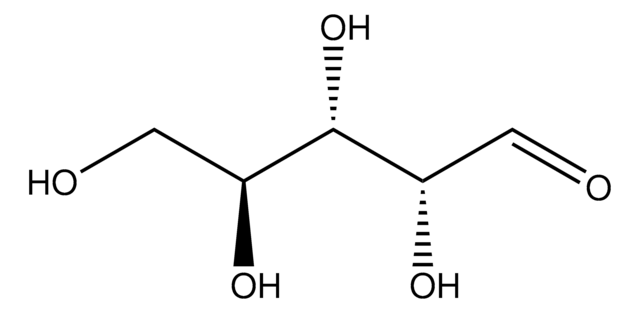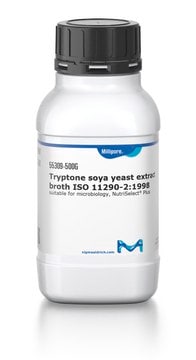Kluczowe dokumenty
10850
D-(−)-Arabinose
suitable for microbiology, ≥99.0%
About This Item
Polecane produkty
Poziom jakości
Próba
≥99.0% (sum of enantiomers, HPLC)
≥99.0%
Formularz
powder
aktywność optyczna
[α]20/D −104±2.0°, 24 hr, c = 10% in H2O
pozostałość po prażeniu
≤0.1% (as SO4)
strata
≤0.1% loss on drying, 20 °C (HV)
mp
162-164 °C (lit.)
ślady anionów
chloride (Cl-): ≤50 mg/kg
sulfate (SO42-): ≤50 mg/kg
ślady kationów
As: ≤0.1 mg/kg
Ca: ≤500 mg/kg
Cd: ≤5 mg/kg
Co: ≤5 mg/kg
Cr: ≤5 mg/kg
Cu: ≤25 mg/kg
Fe: ≤17 mg/kg
K: ≤50 mg/kg
Mg: ≤10 mg/kg
Mn: ≤5 mg/kg
Na: ≤50 mg/kg
Ni: ≤5 mg/kg
Pb: ≤5 mg/kg
Zn: ≤15 mg/kg
Zastosowanie
microbiology
ciąg SMILES
O[C@@H]1COC(O)[C@@H](O)[C@@H]1O
InChI
1S/C5H10O5/c6-2-1-10-5(9)4(8)3(2)7/h2-9H,1H2/t2-,3-,4+,5?/m1/s1
Klucz InChI
SRBFZHDQGSBBOR-ZRMNMSDTSA-N
Szukasz podobnych produktów? Odwiedź Przewodnik dotyczący porównywania produktów
Powiązane kategorie
Opis ogólny
Zastosowanie
Działania biochem./fizjol.
Kod klasy składowania
11 - Combustible Solids
Klasa zagrożenia wodnego (WGK)
WGK 3
Temperatura zapłonu (°F)
Not applicable
Temperatura zapłonu (°C)
Not applicable
Środki ochrony indywidualnej
Eyeshields, Gloves, type N95 (US)
Wybierz jedną z najnowszych wersji:
Masz już ten produkt?
Dokumenty związane z niedawno zakupionymi produktami zostały zamieszczone w Bibliotece dokumentów.
Klienci oglądali również te produkty
Produkty
Podłoże hodowlane zapewnia środowisko z odpowiednimi składnikami odżywczymi, źródłami energii i określonymi warunkami środowiskowymi dla wzrostu mikroorganizmów. Składniki podłoża hodowlanego obejmują zarówno cukry proste, jak i peptony, sole, antybiotyki i złożone wskaźniki.
Nasz zespół naukowców ma doświadczenie we wszystkich obszarach badań, w tym w naukach przyrodniczych, materiałoznawstwie, syntezie chemicznej, chromatografii, analityce i wielu innych dziedzinach.
Skontaktuj się z zespołem ds. pomocy technicznej






